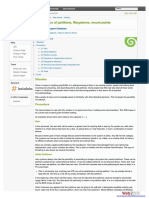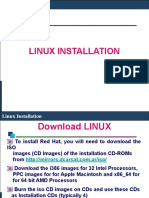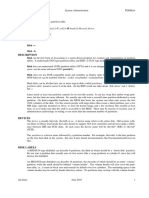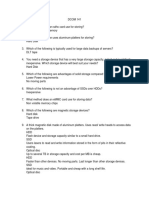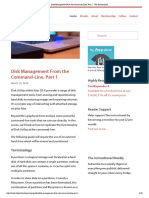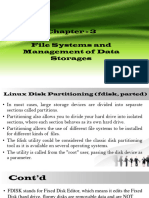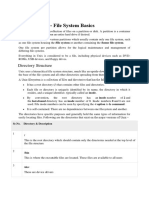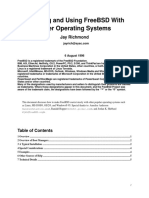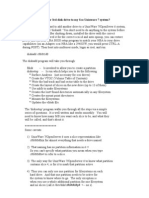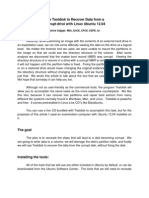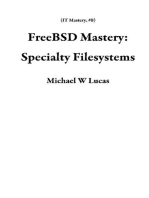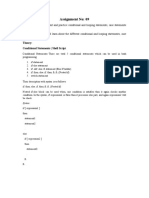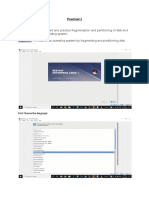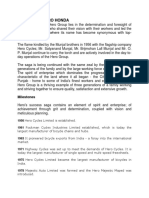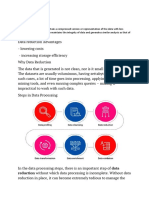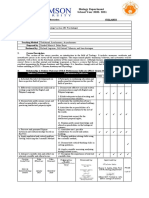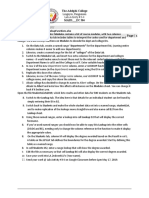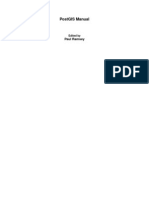Objective: Commands To Check Hard Disk Partitions and Disk Space On Linux
Uploaded by
सतीश पाण्डेय (पाण्डेय जी)Objective: Commands To Check Hard Disk Partitions and Disk Space On Linux
Uploaded by
सतीश पाण्डेय (पाण्डेय जी)Assignment 7
Aim: To study, implement and practice unique Disk commands-disk related commands, checking disk
free spaces.
Objective: commands to check hard disk partitions and disk space on Linux
Theory:
In this practical we are taking a look at some commands that can be used to check up the partitions on
your system. The commands would check what partitions there are on each disk and other details like
the total size, used up space and file system etc.
Commands like fdisk, sfdisk and cfdisk are general partitioning tools that can not only display the
partition information, but also modify them.
1. fdisk
Fdisk is the most commonly used command to check the partitions on a disk. The fdisk command can
display the partitions and details like file system type. However it does not report the size of each
partitions.
Each device is reported separately with details about size, seconds, id and individual partitions.
2. sfdisk
Sfdisk is another utility with a purpose similar to fdisk, but with more features. It can display the size
of each partition in MB.
3. cfdisk
Cfdisk is a linux partition editor with an interactive user interface based on ncurses. It can be used to
list out the existing partitions as well as create or modify them.
Here is an example of how to use cfdisk to list the partitions.
Cfdisk works with one partition at a time. So if you need to see the details of a particular disk, then
pass the device name to cfdisk.
4. parted
Parted is yet another command line utility to list out partitions and modify them if needed.
Here is an example that lists out the partition details.
5. df
Df is not a partitioning utility, but prints out details about only mounted file systems. The list
generated by df even includes file systems that are not real disk partitions.
Here is a simple example
Only the file systems that start with a /dev are actual devices or partitions.
Use grep to filter out real hard disk partitions/file systems.
To display only real disk partitions along with partition type, use df like this
Note that df shows only the mounted file systems or partitions and not all.
6. pydf
Improved version of df, written in python. Prints out all the hard disk partitions in a easy to read
manner.
Again, pydf is limited to showing only the mounted file systems.
7. lsblk
Lists out all the storage blocks, which includes disk partitions and optical drives. Details include the
total size of the partition/block and the mount point if any.
Does not report the used/free disk space on the partitions.
If there is no MOUNTPOINT, then it means that the file system is not yet mounted. For cd/dvd this
means that there is no disk.
Lsblk is capbale of displaying more information about each device like the label and model. Check
out the man page for more information
8. blkid
Prints the block device (partitions and storage media) attributes like uuid and file system type. Does
not report the space on the partitions.
9. hwinfo
The hwinfo is a general purpose hardware information tool and can be used to print out the disk and
partition list. The output however does not print details about each partition like the above commands.
Conclusion: In the above practical we learn about the different commands for getting information about
the disks and its partitions.
You might also like
- Useful Linux Commands DF - H: 1. View All Existing Disk Partitions Using Fdisk - LNo ratings yetUseful Linux Commands DF - H: 1. View All Existing Disk Partitions Using Fdisk - L2 pages
- Linux System Administration For Researchers: Chapter 9: FilesystemsNo ratings yetLinux System Administration For Researchers: Chapter 9: Filesystems38 pages
- Session-6-MANAGING PARTITIONS & FILE SYSTEMSNo ratings yetSession-6-MANAGING PARTITIONS & FILE SYSTEMS26 pages
- Ubuntu - How To Mount A New Disk Partition and Format Storage Devices in Linux - DigitalOceanNo ratings yetUbuntu - How To Mount A New Disk Partition and Format Storage Devices in Linux - DigitalOcean17 pages
- Disk Management From The Command-Line, Part 1 - The InstructionalNo ratings yetDisk Management From The Command-Line, Part 1 - The Instructional10 pages
- Linux Installation: With Thanks To Someone How Did It For Me and Made My Life EasierNo ratings yetLinux Installation: With Thanks To Someone How Did It For Me and Made My Life Easier46 pages
- Partition The New Disk: Fdisk /dev/hdb Hda HDB HDC HDD /dev /dev /dev/hda4No ratings yetPartition The New Disk: Fdisk /dev/hdb Hda HDB HDC HDD /dev /dev /dev/hda42 pages
- 8 Linux Parted' Commands To Create, Resize and Rescue Disk PartitionsNo ratings yet8 Linux Parted' Commands To Create, Resize and Rescue Disk Partitions13 pages
- 8 Linux Parted' Commands To Create, Resize and Rescue Disk PartitionsNo ratings yet8 Linux Parted' Commands To Create, Resize and Rescue Disk Partitions13 pages
- Linux Essentials: Bootdisks and The Boot ProcessNo ratings yetLinux Essentials: Bootdisks and The Boot Process30 pages
- What Is O.S.: Hardware, Memory, Processes and Applications. An100% (1)What Is O.S.: Hardware, Memory, Processes and Applications. An18 pages
- Larktech Slackware Linux Installation Guide: System RequirementsNo ratings yetLarktech Slackware Linux Installation Guide: System Requirements24 pages
- Unit - 5 UNIX / Linux - File System Basics: Directory StructureNo ratings yetUnit - 5 UNIX / Linux - File System Basics: Directory Structure41 pages
- 7 Linux fdisk Command Examples to Manage Hard Disk PartitionNo ratings yet7 Linux fdisk Command Examples to Manage Hard Disk Partition15 pages
- Operating System - Some Fundamental DOS Commands, Rules For Naming Files in DOS and Types of FilesNo ratings yetOperating System - Some Fundamental DOS Commands, Rules For Naming Files in DOS and Types of Files13 pages
- Partitioning and Formatting A Disk Drive in LinuxNo ratings yetPartitioning and Formatting A Disk Drive in Linux13 pages
- Use Testdisk To Recover Data From A Corrupt Drive With Linux UbuntuNo ratings yetUse Testdisk To Recover Data From A Corrupt Drive With Linux Ubuntu17 pages
- Chapter 12. Managing Disk Storage: Red Hat Enterprise Linux 4: System Administration GuideNo ratings yetChapter 12. Managing Disk Storage: Red Hat Enterprise Linux 4: System Administration Guide6 pages
- Free Open Source Linux OS For Data Recovery & Data Rescue Bilingual Version UltimateFrom EverandFree Open Source Linux OS For Data Recovery & Data Rescue Bilingual Version UltimateNo ratings yet
- SR - No Username User Type Password Email Mob. NoNo ratings yetSR - No Username User Type Password Email Mob. No1 page
- Create A Web Site Using Joomla. Include The ADMINISTRATION SCREENNo ratings yetCreate A Web Site Using Joomla. Include The ADMINISTRATION SCREEN3 pages
- WAP in C++ To Find The Shortest Path Between Source and Destination Using Warshall's AlgorithmNo ratings yetWAP in C++ To Find The Shortest Path Between Source and Destination Using Warshall's Algorithm4 pages
- Biology Department School Year 2020-2021: Student Outcomes Performance IndicatorNo ratings yetBiology Department School Year 2020-2021: Student Outcomes Performance Indicator17 pages
- The Determinants Is of Private: Investment (In Case of Debre Berhan Town)No ratings yetThe Determinants Is of Private: Investment (In Case of Debre Berhan Town)51 pages
- Oxford Brookes BSC Hons in Applied Accounting Thesis Sample100% (3)Oxford Brookes BSC Hons in Applied Accounting Thesis Sample8 pages
- Big Data Applications in Operations/Supply-Chain Management: A Literature Review.No ratings yetBig Data Applications in Operations/Supply-Chain Management: A Literature Review.38 pages
- Introduction To Computational Medicine and Biomedical EngineeringNo ratings yetIntroduction To Computational Medicine and Biomedical Engineering1 page
- Research Paper: Memory Management in Programming LanguagesNo ratings yetResearch Paper: Memory Management in Programming Languages15 pages
- Quantitative Analytical Methods: Dr. Alistair BensonNo ratings yetQuantitative Analytical Methods: Dr. Alistair Benson77 pages
- DB2 v11.1 - Database Security Guide - SecbookNo ratings yetDB2 v11.1 - Database Security Guide - Secbook400 pages
- On Overview of AC 2021-22 For Masters TrainersNo ratings yetOn Overview of AC 2021-22 For Masters Trainers45 pages
- Generative AI To Generate Test Data Generators: Generative Ai For Software Engineering (Gai For Se)No ratings yetGenerative AI To Generate Test Data Generators: Generative Ai For Software Engineering (Gai For Se)10 pages
- Competing Stimulus Assessments: A Systematic Review: Journal of Applied Behavior Analysis (Fall) 2020, 53, 1982 - 2001 4No ratings yetCompeting Stimulus Assessments: A Systematic Review: Journal of Applied Behavior Analysis (Fall) 2020, 53, 1982 - 2001 420 pages
- Useful Linux Commands DF - H: 1. View All Existing Disk Partitions Using Fdisk - LUseful Linux Commands DF - H: 1. View All Existing Disk Partitions Using Fdisk - L
- Linux System Administration For Researchers: Chapter 9: FilesystemsLinux System Administration For Researchers: Chapter 9: Filesystems
- Ubuntu - How To Mount A New Disk Partition and Format Storage Devices in Linux - DigitalOceanUbuntu - How To Mount A New Disk Partition and Format Storage Devices in Linux - DigitalOcean
- Disk Management From The Command-Line, Part 1 - The InstructionalDisk Management From The Command-Line, Part 1 - The Instructional
- Linux Installation: With Thanks To Someone How Did It For Me and Made My Life EasierLinux Installation: With Thanks To Someone How Did It For Me and Made My Life Easier
- Partition The New Disk: Fdisk /dev/hdb Hda HDB HDC HDD /dev /dev /dev/hda4Partition The New Disk: Fdisk /dev/hdb Hda HDB HDC HDD /dev /dev /dev/hda4
- 8 Linux Parted' Commands To Create, Resize and Rescue Disk Partitions8 Linux Parted' Commands To Create, Resize and Rescue Disk Partitions
- 8 Linux Parted' Commands To Create, Resize and Rescue Disk Partitions8 Linux Parted' Commands To Create, Resize and Rescue Disk Partitions
- What Is O.S.: Hardware, Memory, Processes and Applications. AnWhat Is O.S.: Hardware, Memory, Processes and Applications. An
- Larktech Slackware Linux Installation Guide: System RequirementsLarktech Slackware Linux Installation Guide: System Requirements
- Unit - 5 UNIX / Linux - File System Basics: Directory StructureUnit - 5 UNIX / Linux - File System Basics: Directory Structure
- 7 Linux fdisk Command Examples to Manage Hard Disk Partition7 Linux fdisk Command Examples to Manage Hard Disk Partition
- Operating System - Some Fundamental DOS Commands, Rules For Naming Files in DOS and Types of FilesOperating System - Some Fundamental DOS Commands, Rules For Naming Files in DOS and Types of Files
- Use Testdisk To Recover Data From A Corrupt Drive With Linux UbuntuUse Testdisk To Recover Data From A Corrupt Drive With Linux Ubuntu
- Chapter 12. Managing Disk Storage: Red Hat Enterprise Linux 4: System Administration GuideChapter 12. Managing Disk Storage: Red Hat Enterprise Linux 4: System Administration Guide
- FreeBSD Mastery: Storage Essentials: IT Mastery, #4From EverandFreeBSD Mastery: Storage Essentials: IT Mastery, #4
- FreeBSD Mastery: Specialty Filesystems: IT Mastery, #8From EverandFreeBSD Mastery: Specialty Filesystems: IT Mastery, #8
- Free Open Source Linux OS For Data Recovery & Data Rescue Bilingual Version UltimateFrom EverandFree Open Source Linux OS For Data Recovery & Data Rescue Bilingual Version Ultimate
- Create A Web Site Using Joomla. Include The ADMINISTRATION SCREENCreate A Web Site Using Joomla. Include The ADMINISTRATION SCREEN
- WAP in C++ To Find The Shortest Path Between Source and Destination Using Warshall's AlgorithmWAP in C++ To Find The Shortest Path Between Source and Destination Using Warshall's Algorithm
- Biology Department School Year 2020-2021: Student Outcomes Performance IndicatorBiology Department School Year 2020-2021: Student Outcomes Performance Indicator
- The Determinants Is of Private: Investment (In Case of Debre Berhan Town)The Determinants Is of Private: Investment (In Case of Debre Berhan Town)
- Oxford Brookes BSC Hons in Applied Accounting Thesis SampleOxford Brookes BSC Hons in Applied Accounting Thesis Sample
- Big Data Applications in Operations/Supply-Chain Management: A Literature Review.Big Data Applications in Operations/Supply-Chain Management: A Literature Review.
- Introduction To Computational Medicine and Biomedical EngineeringIntroduction To Computational Medicine and Biomedical Engineering
- Research Paper: Memory Management in Programming LanguagesResearch Paper: Memory Management in Programming Languages
- Quantitative Analytical Methods: Dr. Alistair BensonQuantitative Analytical Methods: Dr. Alistair Benson
- Generative AI To Generate Test Data Generators: Generative Ai For Software Engineering (Gai For Se)Generative AI To Generate Test Data Generators: Generative Ai For Software Engineering (Gai For Se)
- Competing Stimulus Assessments: A Systematic Review: Journal of Applied Behavior Analysis (Fall) 2020, 53, 1982 - 2001 4Competing Stimulus Assessments: A Systematic Review: Journal of Applied Behavior Analysis (Fall) 2020, 53, 1982 - 2001 4












